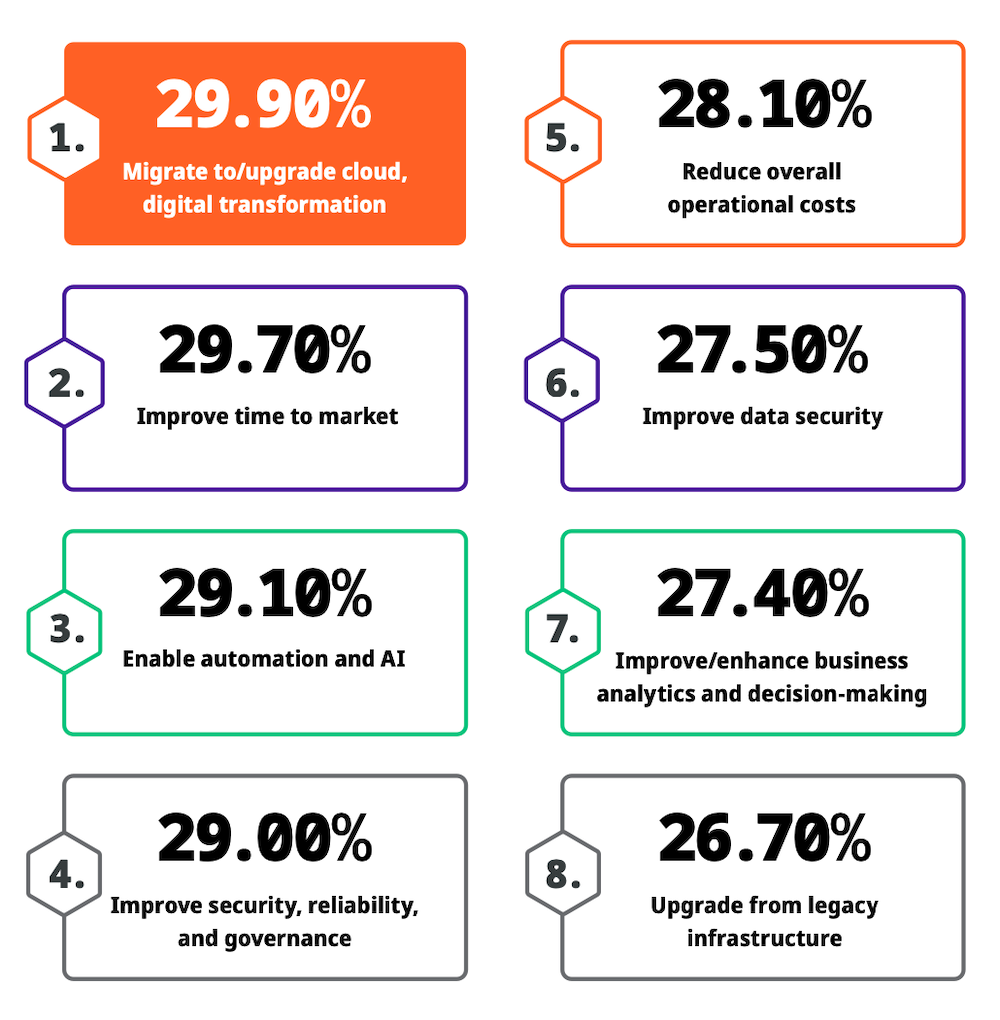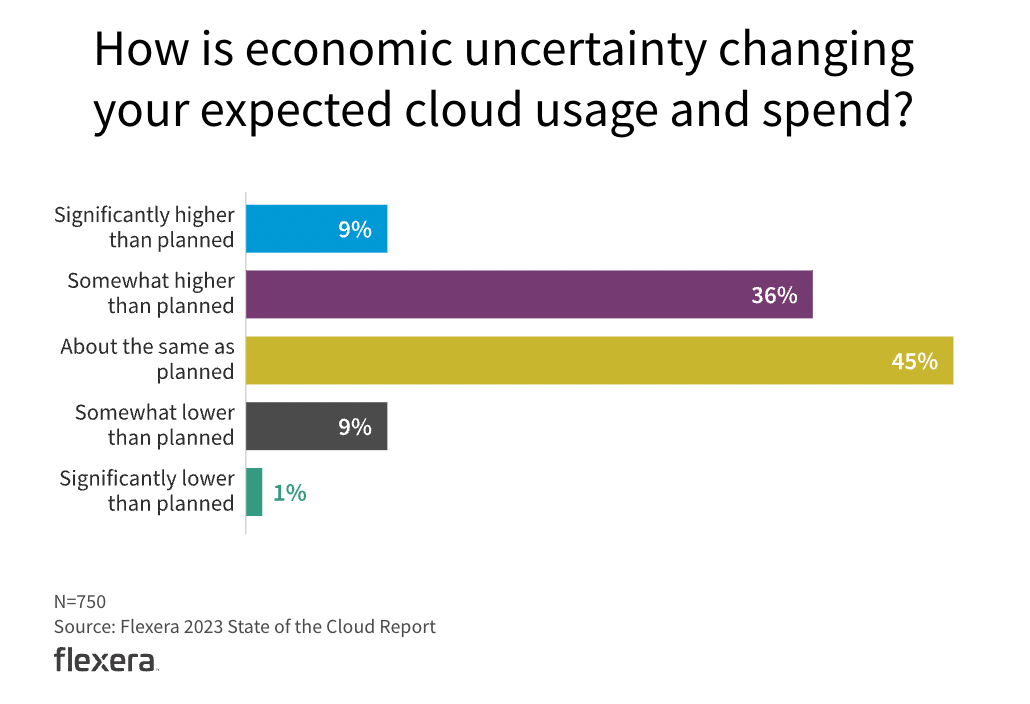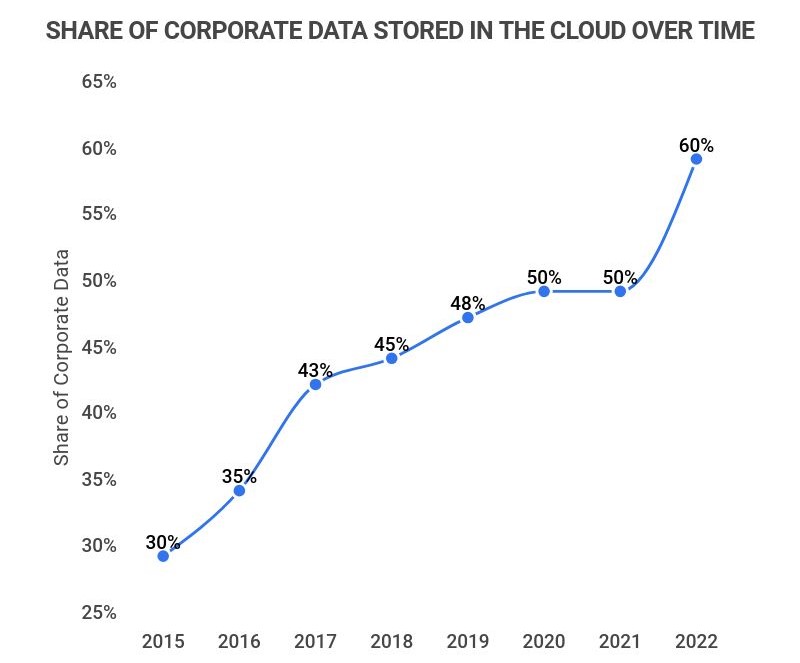maio 16, 2023
Em 2023, a Digibee realizou nosso segundo Pesquisa de integração do estado da empresa, alcançando mil CTOs, CIOs, arquitetos de sistema e desenvolvedores da Web na América do Norte.
Nesta série, examinamos as principais descobertas descobertas no relatório, incluindo o objetivo número um das organizações ao implementar a integração empresarial: migração de nuvem.
Por que a migração para a nuvem é tão importante?
Os entrevistados da pesquisa identificam oito prioridades. Embora a classificação seja relativamente uniforme, Migrar para/atualizar a nuvem, a transformação digital está no primeiro lugar.

Então, por que tantos líderes de negócios e tecnologia priorizam a migração para a nuvem como o objetivo mais importante da integração corporativa?
$ 206.1 bilhões
Mercado de nuvem pública nos EUA até o final de 2022
Participação no mercado de nuvem
A nuvem está crescendo
O mercado de nuvem está se expandindo a um ritmo incrível. Em 2022, o tamanho do mercado é estimado em US$ 480.04 bilhões. Somente nos EUA, o mercado de nuvem pública foi projetado para atingir US$ 206.1 bilhões até o final de 2022.
Adoção da nuvem
A nuvem está em todo lugar
A infraestrutura baseada em nuvem é um bloco de construção crítico na jornada de transformação digital de qualquer empresa. Isso fica evidente no ritmo de adoção, com 94% das empresas usam serviços de nuvem de algum tipo e mais de 65% da infraestrutura corporativa agora na nuvem.
Depois que a migração para a nuvem é alcançada, as organizações escalam rapidamente e respondem imediatamente às mudanças no mercado. Além disso, novas ferramentas e tecnologias são facilmente implementadas para acelerar o crescimento e a lucratividade do negócio.
Hoje, a nuvem é onipresente, com a maioria das empresas excedendo as estimativas de uso e gastos depois de implementadas.

Segurança e armazenamento na nuvem
A nuvem é um equalizador
A nuvem nivela o campo de atuação, fornecendo recursos de segurança e armazenamento além do alcance (e do orçamento) da maioria das empresas. Qualquer empresa, seja iniciante ou já estabelecida, pode facilmente alavancar recursos na escala de um Amazon Web Services, Google Cloud Platform ou Microsoft Azure simplesmente hospedando sua infraestrutura nessas plataformas.
“A ascensão dos sistemas em nuvem… convenceu muitas empresas, grandes e pequenas, de que hospedar seus dados na nuvem é mais econômico, seguro e conveniente do que manter uma infraestrutura de TI no local.“
Forbes, 2023
Gerenciamento e dimensionamento em nuvem
 A nuvem é compatível com dados
A nuvem é compatível com dados
A nuvem escala facilmente. Por exemplo, à medida que você implementa sua estratégia de migração para a nuvem, seu ambiente se torna mais digital, gerando quantidades crescentes de dados de dispositivos e sistemas conectados.
Proteger e implementar uma estratégia de gerenciamento de dados em nuvem torna-se um desafio se sua infraestrutura for incapaz de suportar a carga.
A nuvem, com seus incríveis recursos de armazenamento, oferece armazenamento de dados escalável e seguro. A trajetória acentuada dos dados corporativos armazenados na nuvem ao longo do tempo reflete essa tendência crescente.
Como funciona a migração para a nuvem?
O tipo mais comum de migração para a nuvem é a re-hospedagem, em que uma empresa migra aplicativos locais para uma nuvem privada ou pública.
Raramente uma empresa hospedará novamente (ou levantará e mudará) todo o seu ecossistema de TI de uma só vez. Em vez disso, a empresa cria uma estratégia de migração para a nuvem que incorpora uma abordagem em fases, determinando quais sistemas migrar primeiro e quais sistemas permanecerão no local. Em determinados cenários, por exemplo, para cumprir os regulamentos do governo e do setor, alguns sistemas sempre serão hospedados no local.
Outros tipos comuns de migração para a nuvem incluem:
- Reestruturação: durante a migração, um aplicativo é reprojetado para funcionar melhor em um ambiente de nuvem.
- Nova plataforma: os sistemas legados são modificados para funcionar de maneira ideal na nuvem sem reescrever a arquitetura principal.
Independentemente do modelo, o resultado é um ambiente híbrido onde os aplicativos e plataformas devem permanecer conectados, sejam eles hospedados no local ou na nuvem.
Superando os desafios da migração para a nuvem com o iPaaS da Digibee
Com tantas oportunidades, não é surpresa que mais de 70% dos líderes pesquisados são ativamente planejando adotar, complementar ou substituir sua tecnologia de integração em 2023.
A plataforma de integração nativa da nuvem exclusiva da Digibee agiliza o processo de migração, minimizando as interrupções e garantindo uma transição suave, enquanto superando desafios comuns incluindo:
- Desempenho e continuidade dentro do ambiente de nuvem
- Gestão de custos para controle contínuo dos custos e desperdícios da nuvem
- Governance para controlar o provisionamento, a entrega da infraestrutura e a operação geral
- Gerenciamento de operações para otimizar a eficiência e a segurança
- Observabilidade por meio de dados internos e externos para melhorar o desempenho dos recursos e o tempo de atividade
- Segurança em ambientes locais e sistemas baseados em nuvem
A integração corporativa é fundamental para alcançar importantes iniciativas de transformação digital que modernizam e garantem o sucesso do seu negócio. Sem ela, a migração para a nuvem é difícil e muitas vezes impossível.
Obtenha a história completa sobre o que mudou e como seus colegas estão mobilizando a integração empresarial em 2023. Faça o download gratuito do relatório Digibee 2023 State of Enterprise Integration hoje para todos os resultados da pesquisa e a análise.









